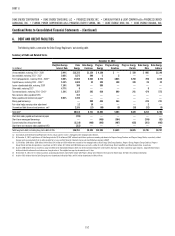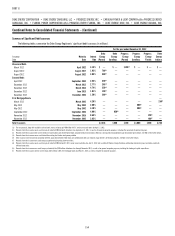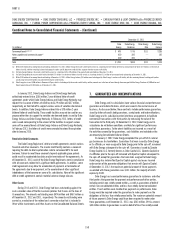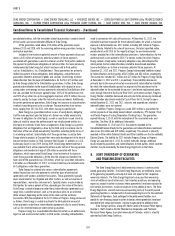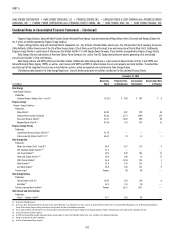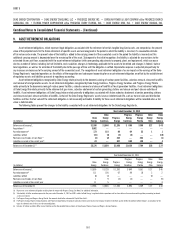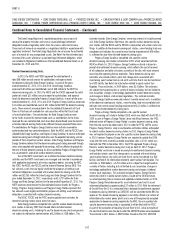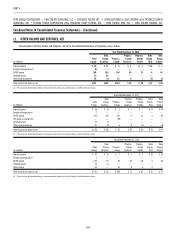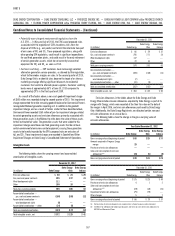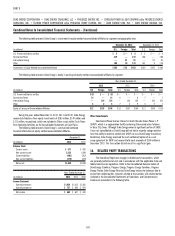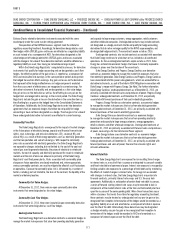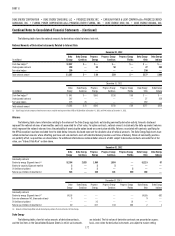Duke Energy 2012 Annual Report Download - page 182
Download and view the complete annual report
Please find page 182 of the 2012 Duke Energy annual report below. You can navigate through the pages in the report by either clicking on the pages listed below, or by using the keyword search tool below to find specific information within the annual report.
162
PART II
Combined Notes to Consolidated Financial Statements – (Continued)
DUKE ENERGY CORPORATION • DUKE ENERGY CAROLINAS, LLC • PROGRESS ENERGY, INC. • CAROLINA POWER & LIGHT COMPANY d/b/a PROGRESS ENERGY
CAROLINAS, INC. • FLORIDA POWER CORPORATION d/b/a PROGRESS ENERY FLORIDA, INC. • DUKE ENERGY OHIO, INC. • DUKE ENERGY INDIANA, INC.
The Duke Energy Registrants’ regulated operations accrue costs of
removal for property that does not have an associated legal retirement
obligation based on regulatory orders from the various state commissions.
These costs of removal are recorded as a regulatory liability in accordance with
regulatory treatment. The Duke Energy Registrants do not accrue the estimated
cost of removal for any non regulated assets. See Note 4 for the estimated cost
of removal for assets without an associated legal retirement obligation, which
are included in Regulatory Liabilities on the Consolidated Balance Sheets as of
December 31, 2012 and 2011.
Nuclear Decommissioning Costs.
In 2010, the NCUC and PSCSC approved the retail portion of a
total $48 million annual amount for contributions and expense levels
for decommissioning for Duke Energy Carolinas. In each of the years
ended December 31, 2012, 2011 and 2010, Duke Energy Carolinas
expensed $48 million and contributed cash of $48 million to the NDTF for
decommissioning costs. In 2010, the NCUC and the PSCSC approved the retail
portion of a total $31 million annual amount for contributions and expense
levels for decommissioning for Progress Energy Carolinas. In each of the years
ended December 31, 2012, 2011 and 2010, Progress Energy Carolinas expensed
$31 million and contributed cash of $31 million to the NDTF for decommissioning
costs. These amounts are presented in the Consolidated Statements of Cash
Flows in Purchases of available-for-sale securities within Net Cash Used
in Investing Activities. The contributions for Duke Energy Carolinas were
to the funds reserved for contaminated costs as contributions to the funds
reserved for non-contaminated costs have been discontinued since the current
estimates indicate existing funds to be suffi cient to cover projected future costs.
The contributions for Progress Energy Carolinas were to funds reserved for
contaminated and non-contaminated costs. Both the NCUC and the PSCSC have
allowed Duke Energy Carolinas and Progress Energy Carolinas to recover estimated
decommissioning costs through retail rates over the expected remaining service
periods of their respective nuclear stations. Duke Energy Carolinas and Progress
Energy Carolinas believe that the decommissioning costs being recovered through
rates, when coupled with expected fund earnings, will be suffi cient to provide for
the cost of future decommissioning. As discussed below, Progress Energy Florida
has suspended its accrual for nuclear decommissioning.
Use of the NDTF investments are restricted to nuclear decommissioning
activities and the NDTF investments are managed and invested in accordance
with applicable requirements of various regulatory bodies, including the NRC,
the FERC, the NCUC, the PSCSC and the Internal Revenue Service (IRS). The
fair value of assets that are legally restricted for purposes of settling asset
retirement obligations associated with nuclear decommissioning are $3,941
million and $2,053 million for Duke Energy and Duke Energy Carolinas for the
year ended December 31, 2012, respectively, and $1,797 million for Duke
Energy and Duke Energy Carolinas for the year ended December 31, 2011. The
NDTF balances presented on the Consolidated Balance Sheets for Progress
Energy, Progress Energy Carolinas and Progress Energy Florida represent the
fair value of assets legally restricted for purposes of settling asset retirement
obligations associated with nuclear decommissioning.
The NCUC, PSCSC and the FPSC require updated cost estimates for
decommissioning nuclear plants every fi ve years.
Duke Energy Carolinas completed site-specifi c nuclear decommissioning
cost studies in January 2009 that showed total estimated nuclear
decommissioning costs, including the cost to decommission plant components
not subject to radioactive contamination, of $3 billion in 2008 dollars. This
estimate includes Duke Energy Carolinas’ ownership interest in its jointly owned
unit. Duke Energy Carolinas fi led these site-specifi c nuclear decommissioning
cost studies with the NCUC and the PSCSC in conjunction with various rate case
fi lings. In addition to the decommissioning cost studies, a new funding study was
completed and indicates the current annual funding requirement of $48 million
is suffi cient to cover the estimated decommissioning costs.
Progress Energy Carolinas completed site-specifi c nuclear
decommissioning cost studies in December 2009, which were fi led with the
NCUC on March 16, 2010. Progress Energy Carolinas estimate is based on
prompt dismantlement decommissioning, which refl ects the cost of removal
of all radioactive and other structures currently at the site, with such removal
occurring after operating license expiration. These decommissioning cost
estimates also include interim spent fuel storage costs associated with
maintaining spent nuclear fuel on site until such time that it can be transferred
to a DOE facility. See Note 5 for information related to spent nuclear fuel
litigation. These estimates, in 2009 dollars, were $3.0 billion. The estimates
are subject to change based on a variety of factors including, but not limited to,
cost escalation, changes in technology applicable to nuclear decommissioning
and changes in federal, state or local regulations. This estimate includes
Progress Energy Carolinas ownership interest in jointly owned units. In addition
to the decommissioning cost studies, a new funding study was completed and
indicates the current annual funding requirement of $31 million is suffi cient to
cover the estimated decommissioning costs.
Progress Energy Florida completed a site-specifi c nuclear
decommissioning cost study in October 2008, which was fi led with the FPSC in
2009 as part of Progress Energy Florida’s base rate fi ling. However, the FPSC
deferred review of Progress Energy Florida’s nuclear decommissioning study
from the rate case to be addressed in 2010 in order for FPSC staff to assess
Progress Energy Florida’s study in combination with other utilities anticipated
to submit nuclear decommissioning studies in 2010. Progress Energy Florida
was not required to prepare a new site-specifi c nuclear decommissioning study
in 2010; however, Progress Energy Florida was required to update the 2008
study with the most currently available escalation rates in 2010, which was
fi led with the FPSC in December 2010. The FPSC approved Progress Energy
Florida’s nuclear decommissioning cost study on April 30, 2012. Progress
Energy Florida’s estimate is based on prompt dismantlement decommissioning
and includes interim spent fuel storage costs associated with maintaining
spent nuclear fuel on site until such time that it can be transferred to a DOE
facility. See Note 5 for information related to spent nuclear fuel litigation. The
estimate, in 2008 dollars, is $751 million and is subject to change based on
a variety of factors including, but not limited to, cost escalation, changes in
technology applicable to nuclear decommissioning and changes in federal,
state or local regulations. This estimate includes Progress Energy Florida’s
ownership interest in jointly owned stations. Based on the 2008 estimate,
assumed operating license renewal and updated escalation factors in 2010,
Progress Energy Florida decreased its asset retirement cost and its asset
retirement obligation by approximately $37 million in 2010. With the retirement
of Crystal River Unit 3 it is anticipated that a delayed dismantlement approach
to decommissioning referred to as SAFSTOR, will be submitted to the NRC for
approval. This decommissioning approach is currently utilized at a number of
retired domestic nuclear power plants and is one of three generally accepted
approaches to decommissioning required by the NRC. Once an updated site
specifi c decommissioning study is completed it will be fi led with the FPSC.
As part of the evaluation of repairing Crystal River Unit 3, initial estimates of
the cost to decommission the plant under the SAFSTOR option were developed.
The estimate in 2011 dollars is $989 million. Based on the 2011 SAFSTOR


